
The Moss-Covered Heisenji Hakusan Shrine: Fukui’s Hidden Sanctuary
Guideto Japan
Travel- English
- 日本語
- 简体字
- 繁體字
- Français
- Español
- العربية
- Русский
A Shrine Draped with a Mossy Name
Fukui Prefecture is home to around 80% of Japan’s dinosaur fossils. In March 2024 the Hokuriku Shinkansen extended service to Fukui Station, where visitors are welcomed by numerous dinosaur monuments that highlight the region’s reputation as a “Dinosaur Kingdom.”
The city of Katsuyama, which boasts Chatan, Japan’s largest fossil excavation site, is also home to the Fukui Prefectural Dinosaur Museum in the Muroko district—one of the most popular attractions in the area. As tourist numbers rise, it has become a common itinerary to visit the museum along with Eiheiji, the head temple of the Sōtō Zen sect in the neighboring town of Eiheiji.

A moving Suchomimus tenerensis monument at Fukui Station. (© Nippon.com)
One of Katsuyama’s most historic landmarks is Heisenji Hakusan Shrine, founded over 1,300 years ago. The shrine is often referred to as Moss Temple (koke-dera) or Moss Shrine (koke-miya) due to more than 200 species of moss that blanket its surroundings. The entire area is designated as a National Historic Site under the name “Hakusan Heisenji Ruins.“
However, the shrine’s name can be confusing. Even travel guides often list it as both “Heisenji Hakusan Shrine” and “Hakusan Heizan Temple,” leaving first-time visitors wondering: Is it a temple or a shrine? Which comes first—Heisenji or Hakusan? To truly understand this sacred site, one must delve into its long and complex history.
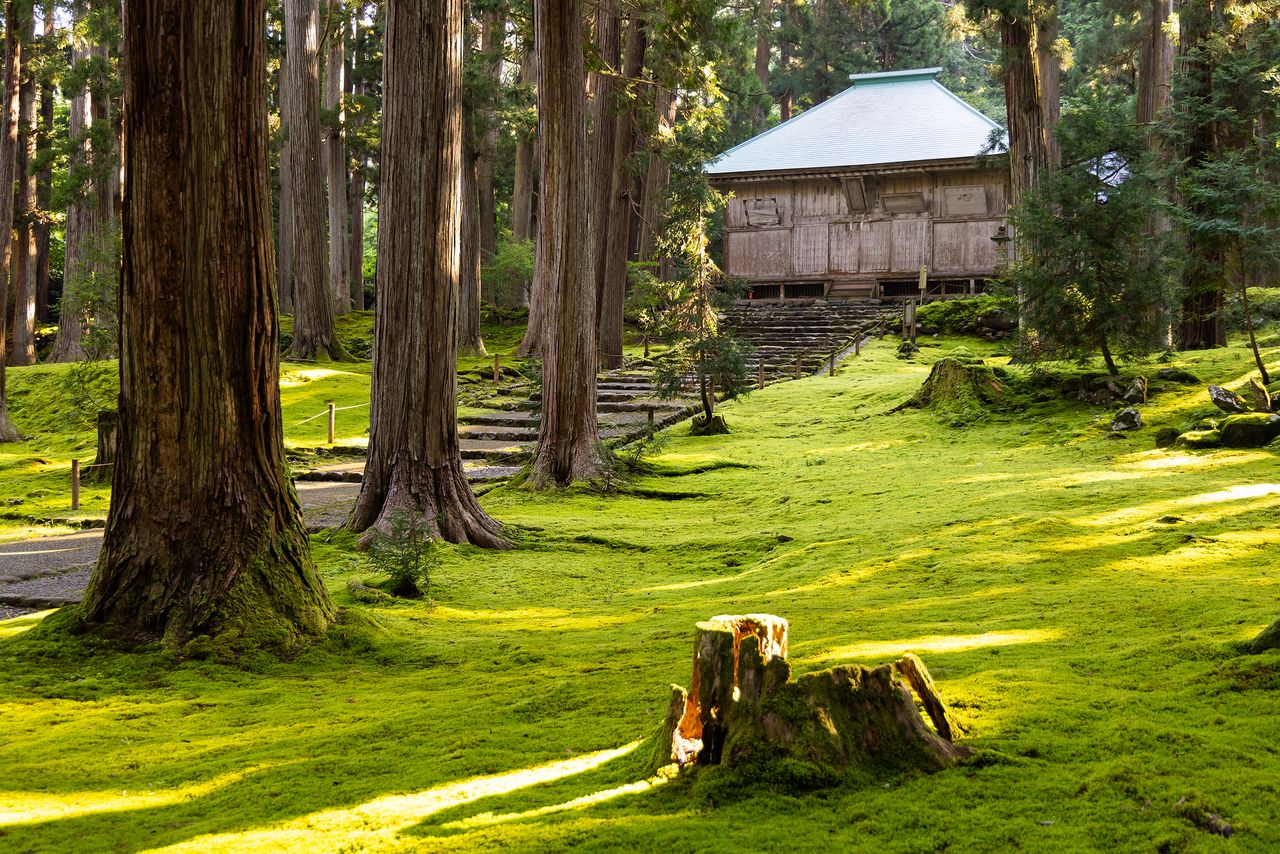
The approach to the worship hall, famous for its exceptionally beautiful moss. (© Nippon.com)
A Holy Site Linked to the Founding of Mount Hakusan Worship
Mount Hakusan, which spans Fukui, Ishikawa, Toyama, and Gifu Prefectures, is one of Japan’s Three Sacred Mountains, alongside Mount Fuji (Yamanashi and Shizuoka) and Mount Tateyama (Toyama). The first recorded ascent of Hakusan was made by the Buddhist monk Taichō Daishi, a practitioner of Shugendō, who was born in Echizen Province (modern-day northern Fukui Prefecture).
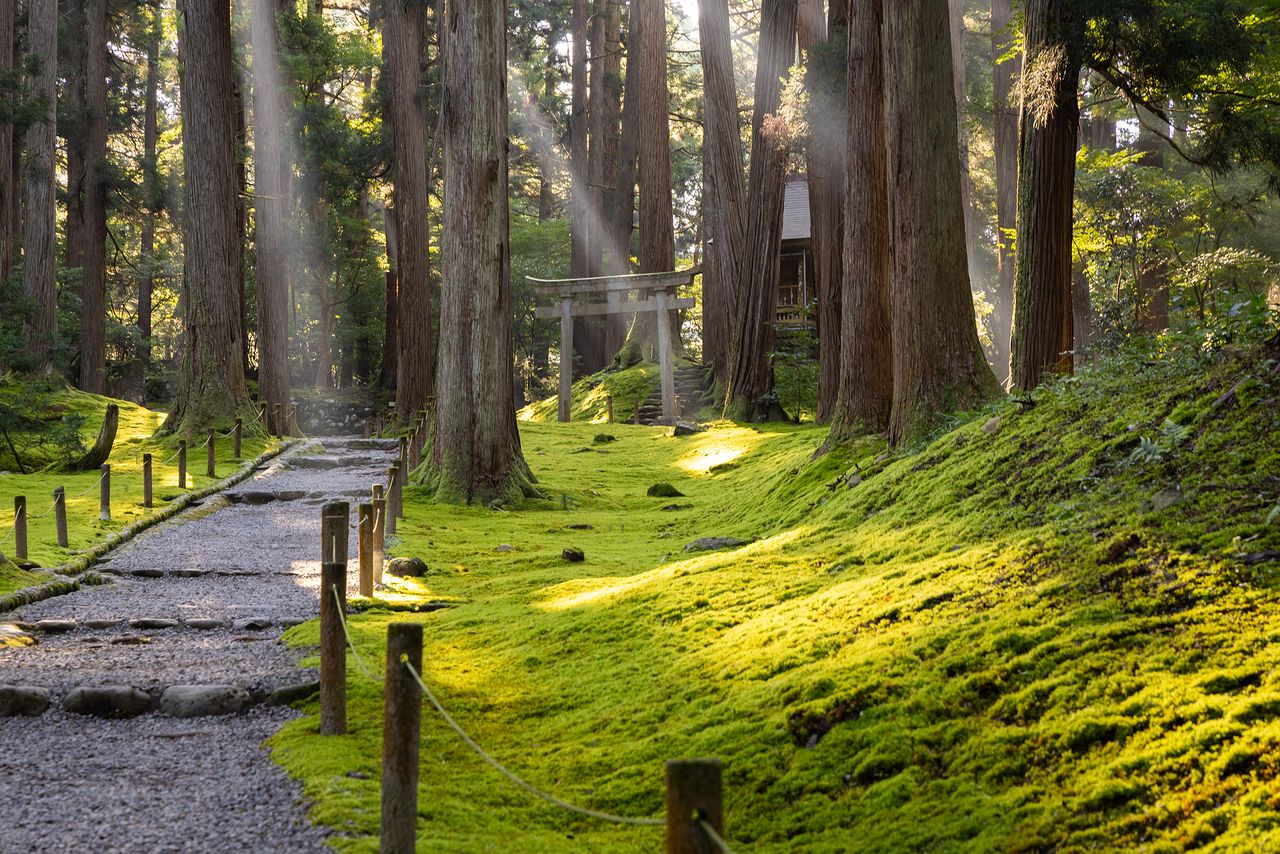
Sporadic sunbeams illuminate the moss on the sacred path leading to the Kaizansha Shrine, which enshrines Taichō. (© Nippon.com)
In the year 717, Taichō was praying at a spring at the foot of the sacred peak when a divine vision appeared. From a sacred rock appearing above the waters of the pond, a goddess emerged and proclaimed, “I am Izanami-no-Mikoto. I am now known as Myōri Daigongen.”
At the time, there was no clear distinction between Shintō and Buddhism, and it was widely believed that Japanese deities could manifest as Buddhas or Bodhisattvas, appearing as gongen (incarnations). Thus, Hakusan Myōri Daigongen was seen as an embodiment of Izanami, the goddess of creation and life.
Guided by this divine revelation, Taichō successfully climbed to the Hakusan summit. After descending, he built a small shrine by the shores of Hiraizumi Pond, where the goddess had appeared. This marked the beginning of what would become a sacred site of syncretic Shintoism and Buddhism.
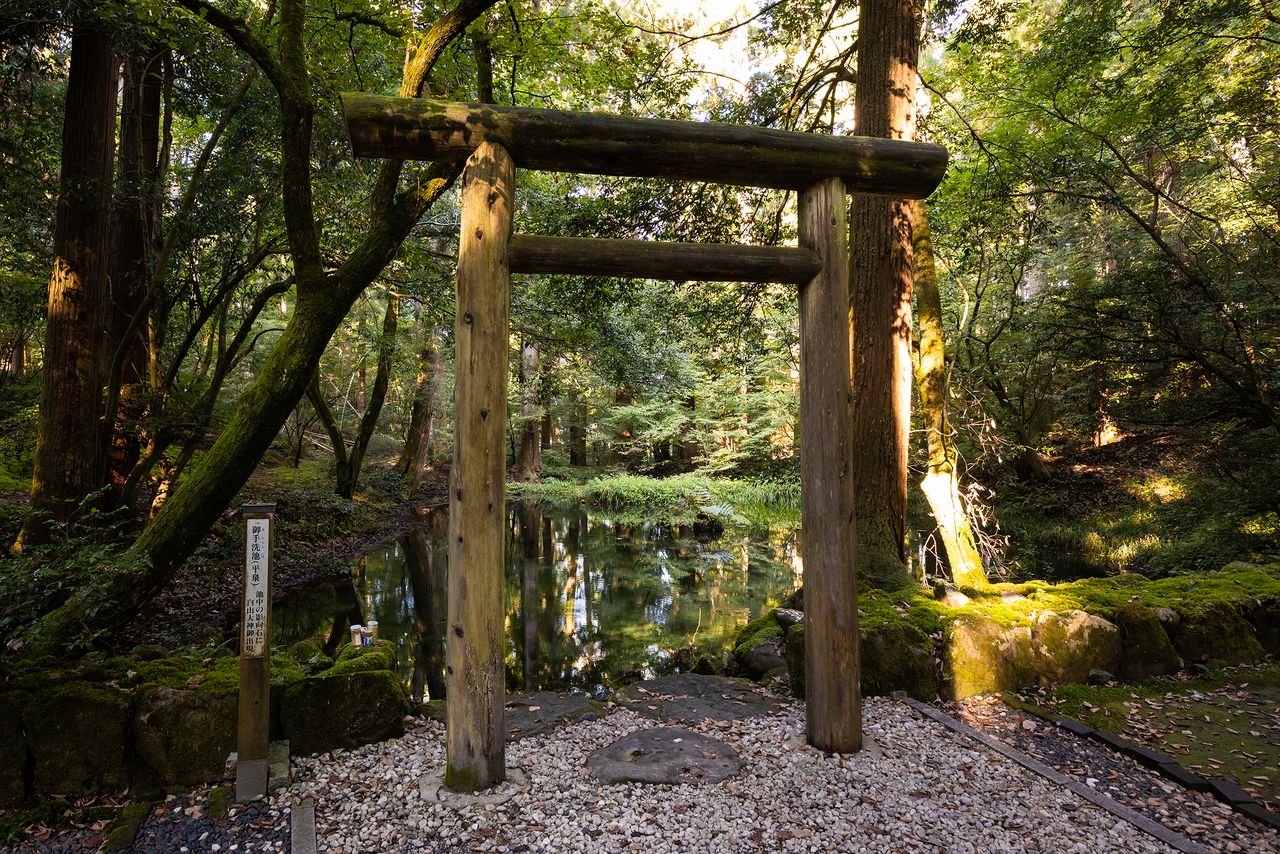
The spring where the goddess appeared is now called Mitarashi Pond or Omitarashi. The small rock visible in the center of the pond is the sacred stone where the goddess appeared. (© Nippon.com)
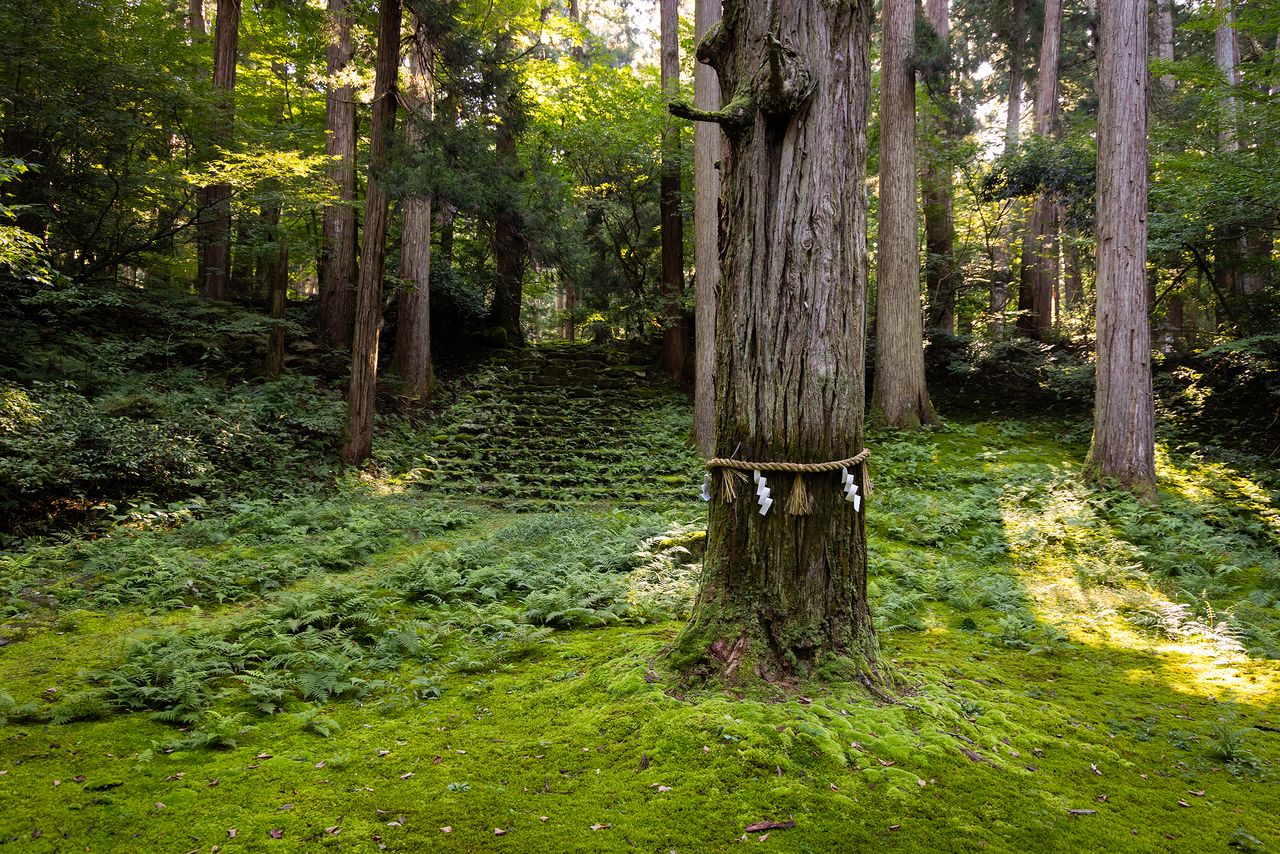
A sacred tree near the spring, said to have been planted by Taichō himself. (© Nippon.com)
A Holy City with 6,000 Monk Quarters
Taichō continued his ascents of Mount Hakusan, spending years training at Hiraizumi and on other peaks in the area while establishing numerous temples and shrines. Eventually, he left Echizen to spread his teachings and was even summoned to the imperial court in Kyoto. As his reputation grew, ultimately earning him the prestigious rank of daisōjō (great prelate), so too did the prominence of Hakusan worship. Hiraizumi, as its spiritual hub, began attracting more and more monks.
In 1172, the temple Enryakuji on Mount Hiei, the head temple of the Tendai sect north of Kyoto, constructed a lecture hall in Hiraizumi. This led to the area being formally named Hiraizumi-dera (the Hiraizumi temple), though over time, the pronunciation shifted to Heisenji. With the powerful influence of Enryakuji, the site flourished into a major holy center. At its peak during the Muromachi period (1333–1568), the complex housed thousands of temple halls and shrines and housing quarters for an astonishing 6,000 monks. The temple’s landholdings reached 90,000 koku, a level of wealth comparable to that of a feudal lord.
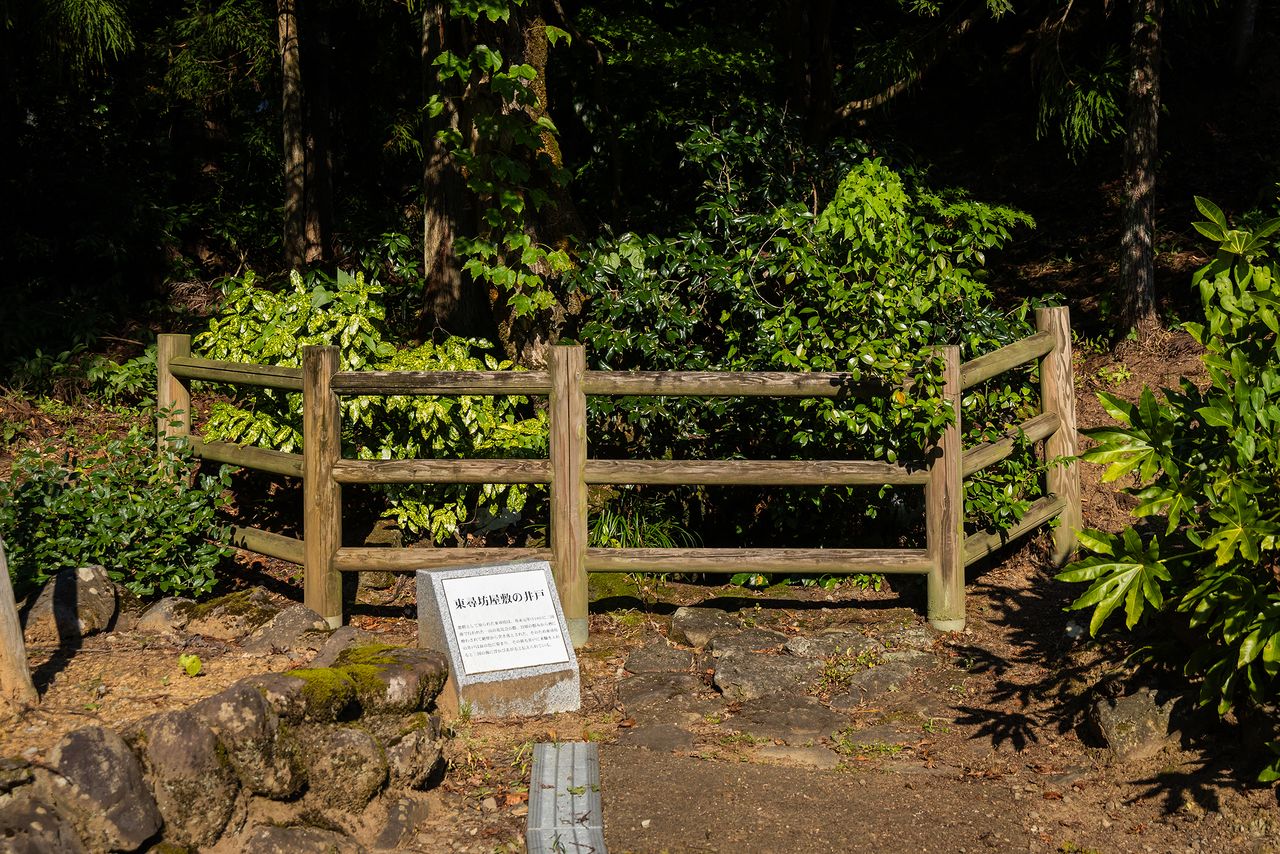
Tōjinbō, a scenic coastal cliff, was named after an evil monk from Heisenji during the late Heian period. A well from Tōjinbō’s former residence still remains beside the old pilgrimage road. (© Nippon.com)
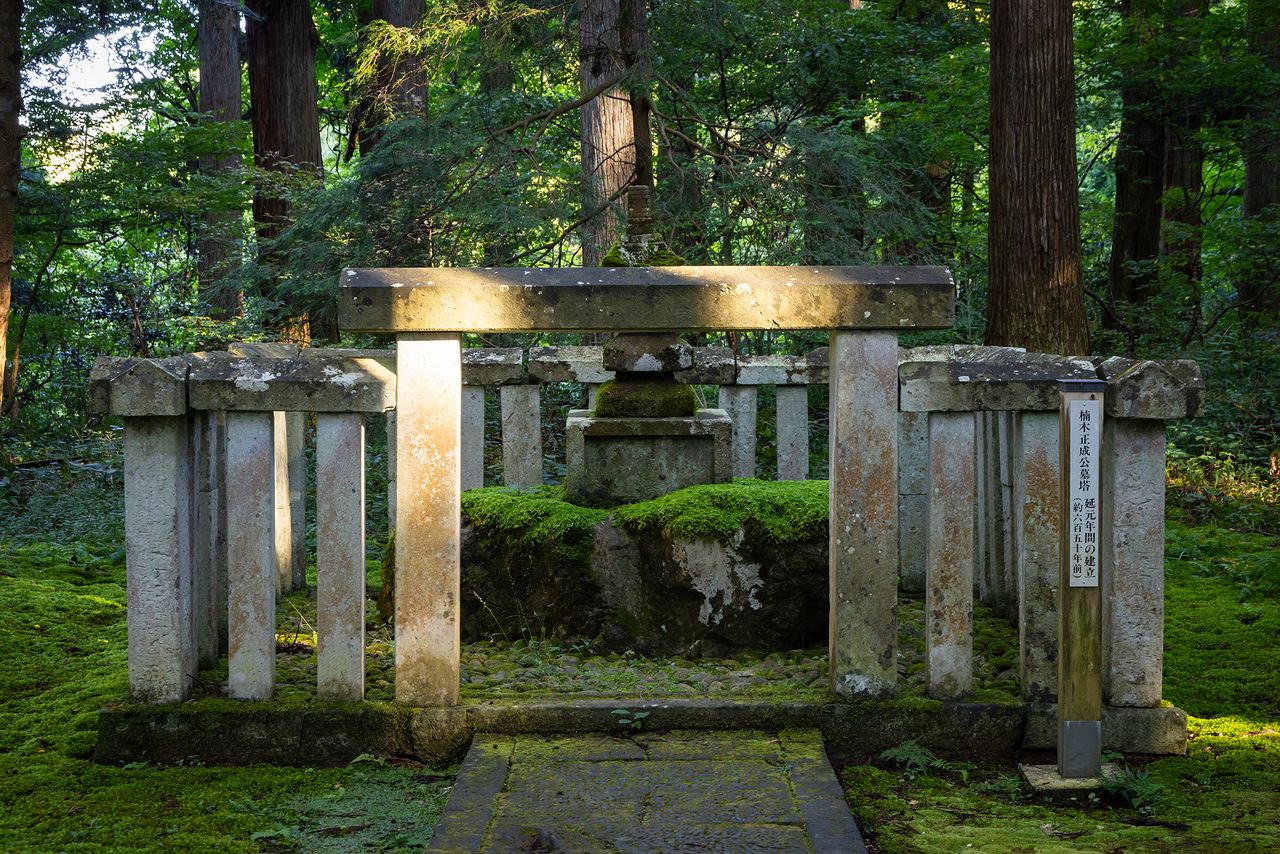
A memorial tower for Kusunoki Masashige, a warrior who played a key role in the Kamakura period (1185–1333), stands near the Third Shrine. It was built in 1336, the year of his death. (© Nippon.com)
However, with power came conflict. At its height, the temple commanded a force of 8,000 warrior monks, making it a formidable presence in the turbulent era of warring factions.
In 1574, the temple sided with Oda Nobunaga, but this allegiance made it a target of the rival Ikkō-ikki (a militant sect of Jōdo Shinshū Buddhists). That year, the Ikkō-ikki launched an attack, burning the entire temple complex to the ground. Interestingly, the Ikkō-ikki’s base during the conflict was Mount Muroko, which was later renamed “Kachiyama” (Victory Mountain) after their triumph. This name was eventually adopted for the city of Katsuyama, preserving its connection to this dramatic chapter in history.
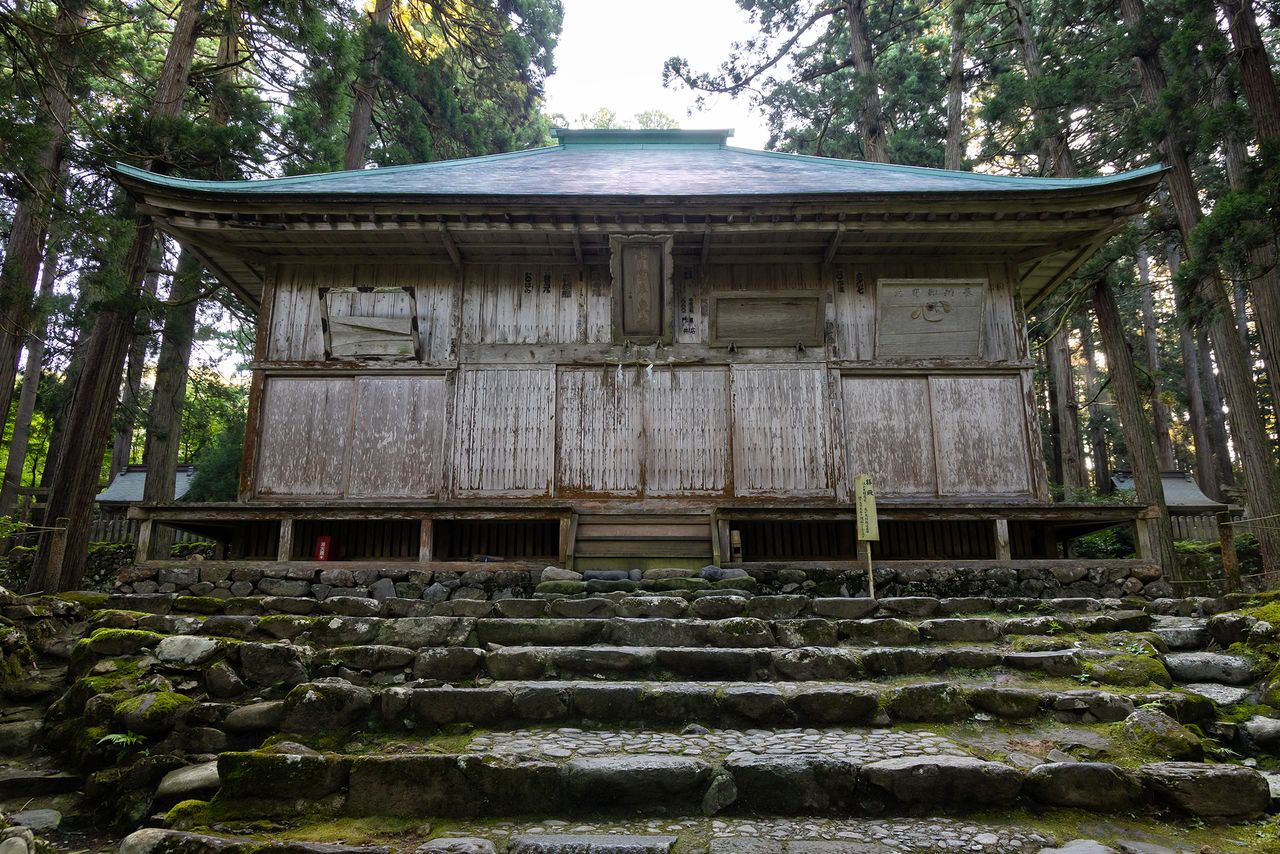
The current worship hall was rebuilt in the late Edo period. The original hall, burned down during the Ikkō-ikki rebellion, was once 46 ken wide (about 83 meters). (© Nippon.com)
The Lost Grandeur of the Original Hakusan Heisenji
Around 10 years after its destruction, the temple was rebuilt with the support of Toyotomi Hideyoshi, but its temple grounds were reduced to just one-tenth of its original size. Even so, during the Edo period (1603–1868), the entire Hakusan region—including Heisenji—came under direct control of the Tokugawa shogunate as a tenryō (shogunate-controlled land). It even secured the right to conduct religious rites at Hakusan’s summit shrine, winning a long-standing dispute with Hakusan Hongū Shrine (now Shirayama Hime Shrine) in Kaga Province (modern-day Ishikawa Prefecture).
However, the Meiji Restoration brought a drastic shift. Under the Shinto-Buddhism Separation Order of the early Meiji period (1868–1912), Heisenji was rebranded as Hakusan Shrine, and all Buddhist elements, including temple halls, were dismantled. The landholdings once granted by the feudal lord were also confiscated. At the same time, control over Hakusan’s summit and pilgrimage routes was transferred to Shirayama Hime Shrine, stripping Heisenji of its former power entirely.
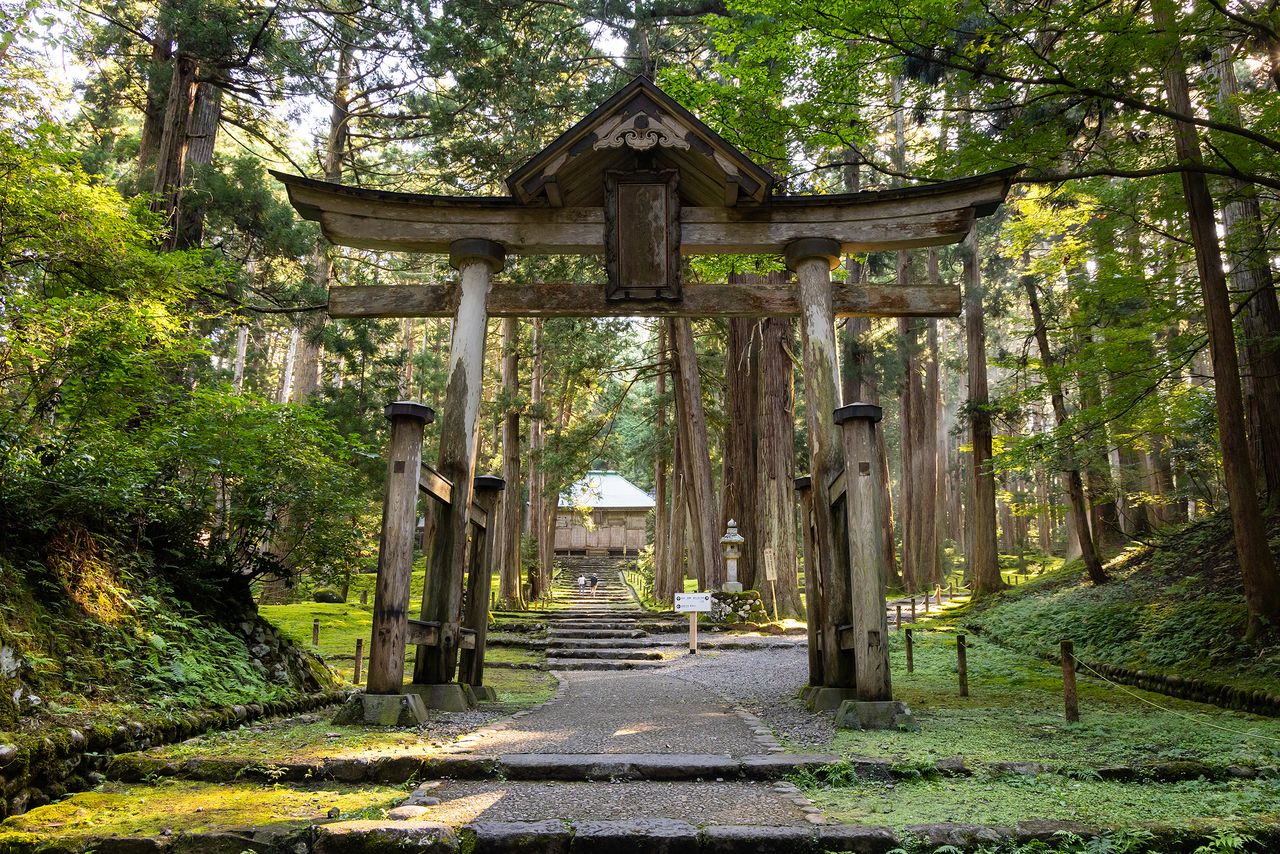
The plaque reading “Hakusan Sansho Daigongen” above the second torii is said to be the handwriting of Prince Kōjun, the son of Emperor Nakamikado and a Tendai priest. A roof was added to protect it from the elements. (© Nippon.com)
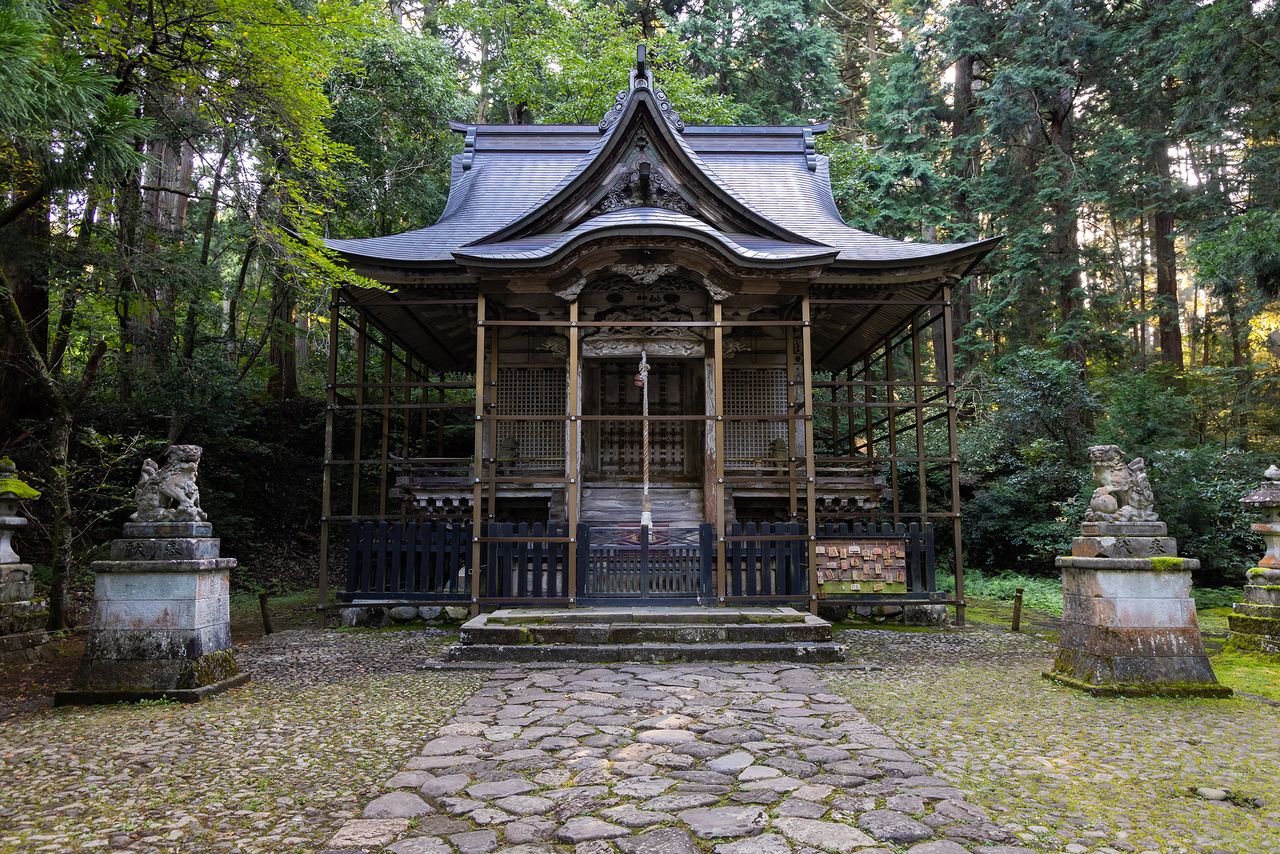
The main shrine, dedicated to Izanami, was rebuilt in 1795 by the feudal lord of Fukui. (© Nippon.com)
In 1935, the site was designated a National Historic Site under the name “Hakusan Heisenji Castle Ruins.” However, its true historical significance wasn’t fully recognized until the 1990s, when large-scale excavations began. A full-fledged archaeological investigation commenced in 1989, focusing on the monastic quarters that had once stretched across the valleys to the north and south of the temple complex. As researchers dug into the earth, they uncovered medieval stone-paved roads, moat remnants, and numerous artifacts from former temple lodgings—including Buddhist ritual objects, samurai armor, and everyday household items. These relics had remained buried in the soil, perfectly preserved since the temple’s destruction in the Ikkō-ikki uprising.
In 1997, the historic site’s designation was expanded tenfold, from 14.6 hectares (the original temple grounds) to a massive 200 hectares, encompassing Minamidani, Kitadani, and surrounding areas. The site was also renamed “Hakusan Heisenji Former Temple Grounds” to better reflect its past as a vast religious city.
Today, the shrine’s official name is “Heisenji Hakusan Shrine,” while the historic ruins that represent the old holy city are referred to as “Hakusan Heisenji.”
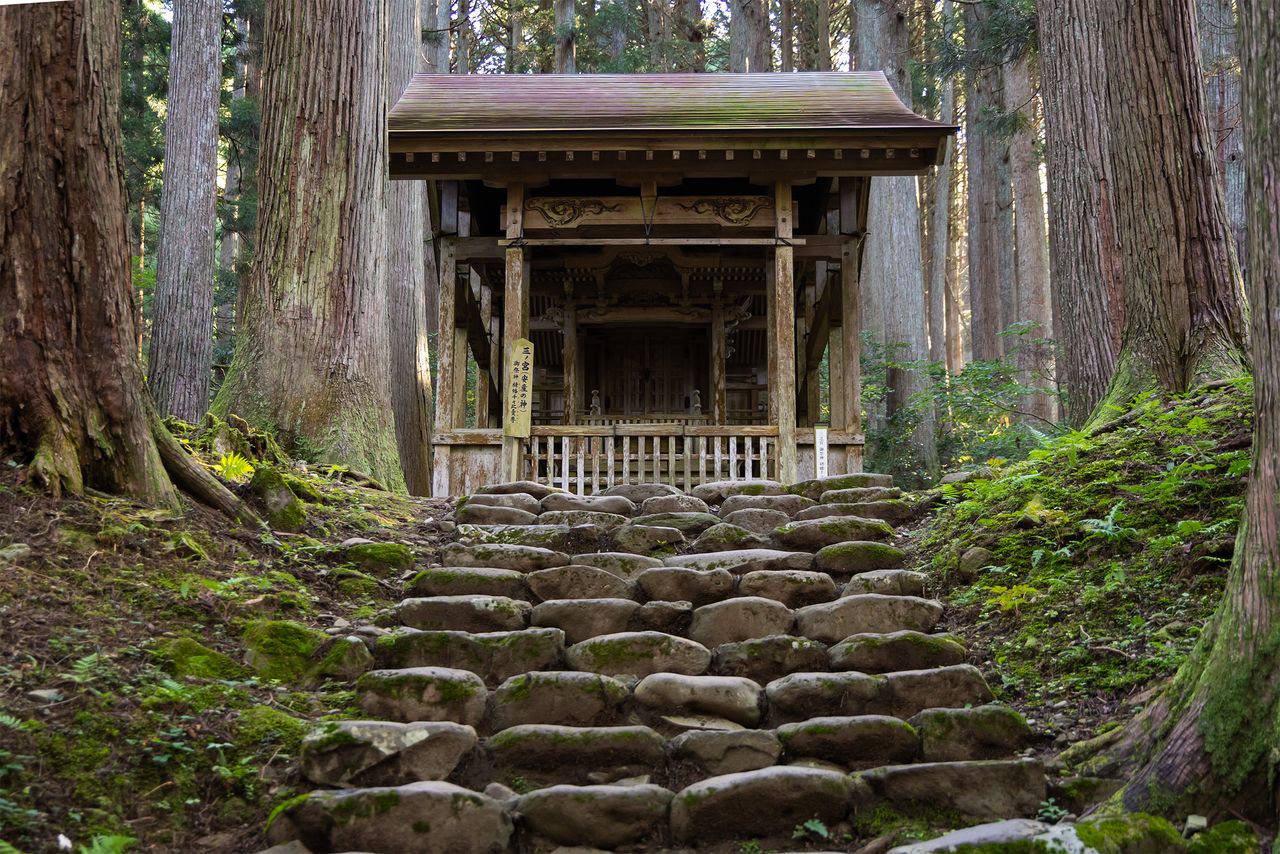
Behind the Third Shrine, a path known as the Echizen Zenjō-dō (Echizen Ascetic Route) once led to the summit of Mount Hakusan. (© Nippon.com)
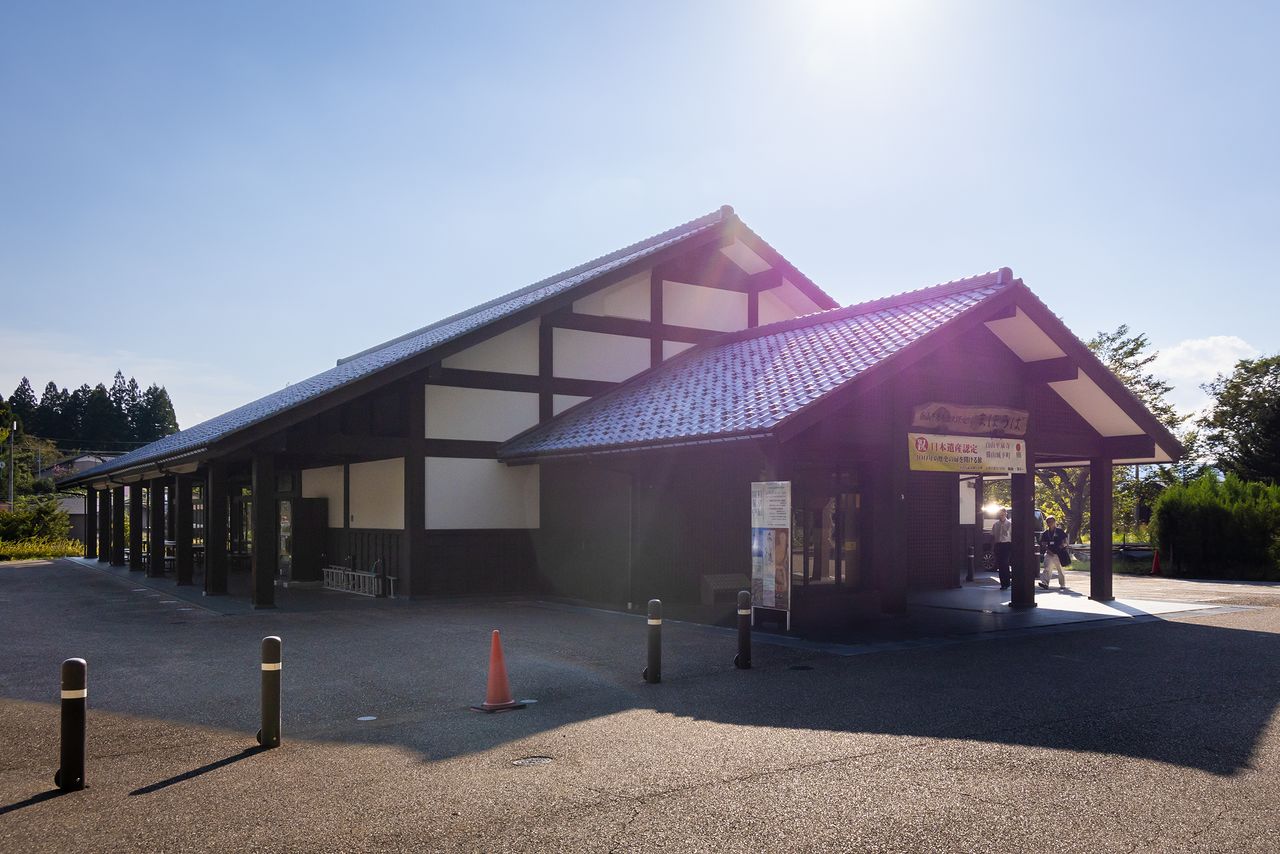
The Hakusan Heisenji History Museum, called Mahoroba, near the entrance to the shrine offers exhibits on the history and culture of the religious site. (© Nippon.com)
Nestled in the mountains, Hiraizumi experiences heavy snowfall in winter, and its high humidity nurtures the lush moss that carpets the shrine grounds. Ironically, this very snowfall may have played a crucial role in preserving the remnants underground, keeping them hidden and untouched for centuries.
While excavations continue to uncover new details, much of medieval Hakusan Heisenji remains a mystery. The work is still far from complete. So, if you find yourself visiting Katsuyama, don’t just stop at the dinosaurs—take a stroll through the Moss Temple and reflect on the vast religious city that still sleeps beneath the earth.
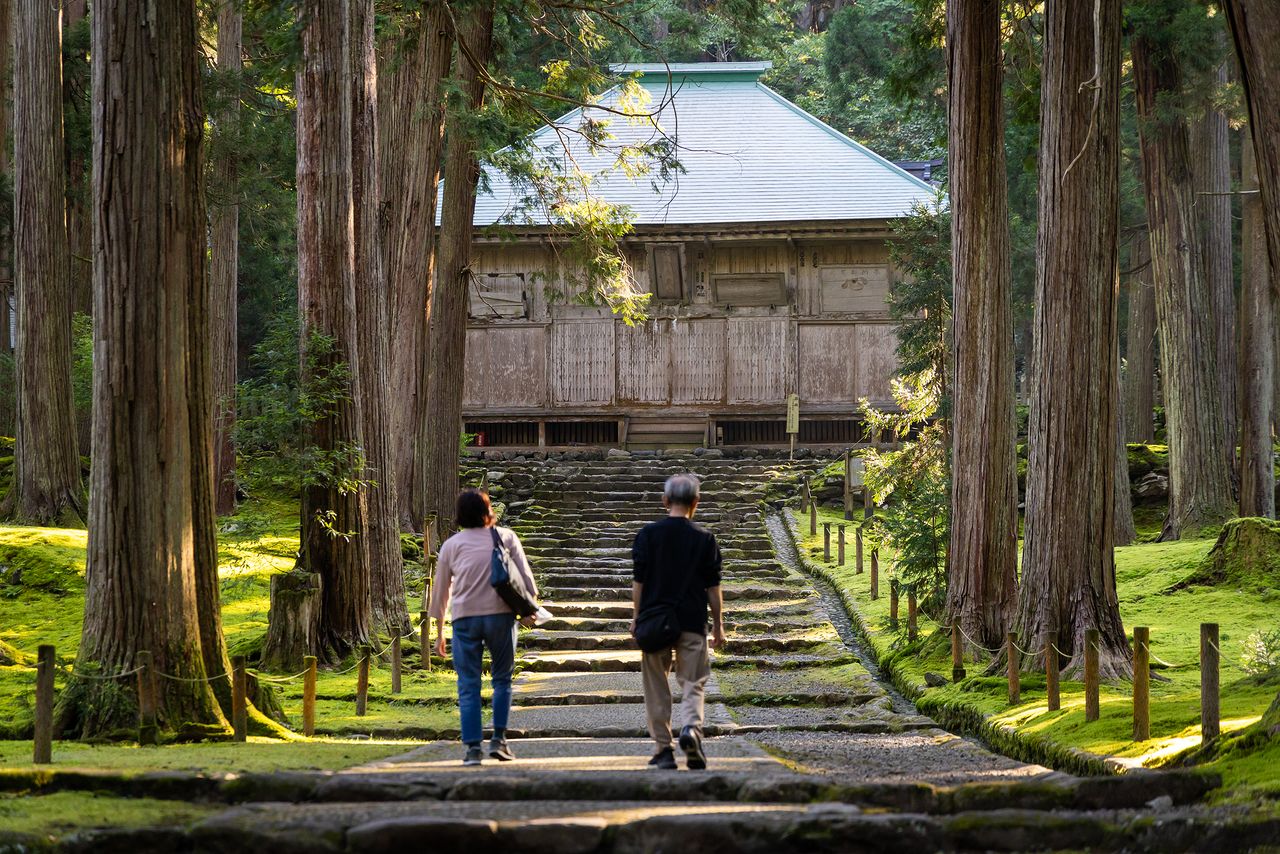
The shrine grounds in the early morning, bathed in breathtaking beauty. (© Nippon.com)
Heisenji Hakusan Shrine
- Location: 56 Heisenji, Heisenjicho, Katsuyama, Fukui Prefecture
- Visiting Hours: Open year-round
- Admission: Free
- Access: Take the Echizen Railway to Katsuyama Station, then board the Heisenji Line bus for about 13 minutes and get off at the Heisenji Hakusan Jinja-mae stop.
By car, it’s a 15-minute drive from the Katsuyama IC exit on the Chūbu Jūkan Expressway.
(Originally published in Japanese. Reporting and text by Nippon.com. Banner photo: The mossy grounds of Heisenji Hakusan Shrine. © Nippon.com. )
